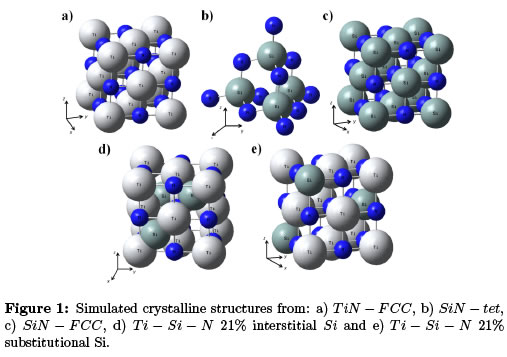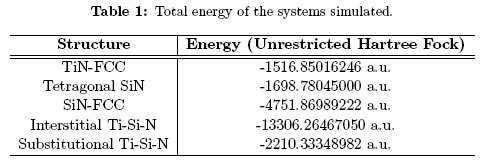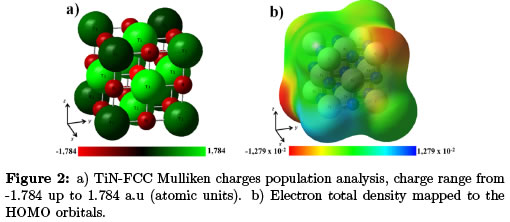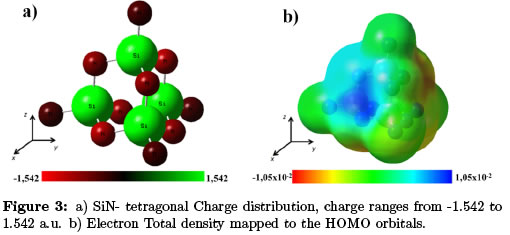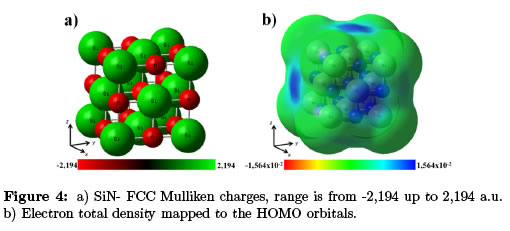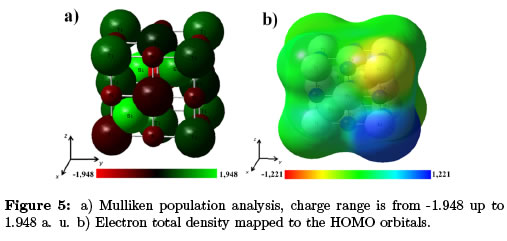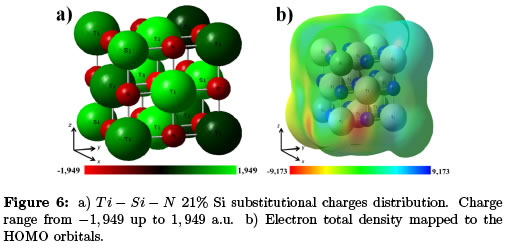Serviços Personalizados
Journal
Artigo
Indicadores
-
 Citado por SciELO
Citado por SciELO -
 Acessos
Acessos
Links relacionados
-
 Citado por Google
Citado por Google -
 Similares em
SciELO
Similares em
SciELO -
 Similares em Google
Similares em Google
Compartilhar
Ingeniería y Ciencia
versão impressa ISSN 1794-9165
ing.cienc. vol.12 no.23 Medellín jan./jun. 2016
https://doi.org/10.17230/ingciencia.12.23.1
ARTÍCULO ORIGINAL
Doi: 10.17230/ingciencia.12.23.1
Influence of Si Atoms Insertion on the Formation of the Ti-Si-N Composite by DFT Simulation
Influencia de la inserción de átomos de Si en la formación del compuesto Ti-Si-N por simulación DFT
Juan Manuel González1, Johans Steeven Restrepo2, Carolina Ortega Portilla3 Alexander Ruden Muñoz4 and Federico Sequeda Osorio 5
1 Universidad del Valle, Cali, Colombia, Juan.gonzalez@correounivalle.edu.co.
2 Universidad Nacional Autónoma de México, Ciudad de México, México, johansrestrepo@hotmail.com.
3 Universidad del Valle, Cali, Colombia, carolinaortega35@gmail.com.
4 Universidad Tecnológica de Pereira, Pereira, Colombia, arudenm@gmail.com.
5 Universidad del Valle, Cali, Colombia, Federico.sequeda@correounivalle.edu.co.
Received: 08-10-2015 | Accepted: 21-01-2016 | Online: 01-02-2016
PACS:31.15.xr
Abstract Using Density Functional Theory (DFT) SiN and T iN structures were simulated, in order to study the influence of the silicon atoms insertion in the T iN lattice placed on interstitial and substitutional positions in a face centered cubic (FCC) crystalline lattice. Results showed that the SiN − FCC structure is pseudo-stable; meanwhile the tetragonal struc- ture is stable with ceramic behavior. The T iN − FCCstructure is stable with ceramic behavior similar to SiN − T etragonal. 21% silicon atoms insertion in interstitial positions showed high induced deformation, high polarization and Si− N bond formation, indication an amorphous transi- tion that could lead to the production of a material composed from T iN grains or nano-grains embedded in a Si − N amorphous matrix. When including 21% of silicon atoms, substituting titanium atoms, the distribu- tion showed higher stability that could lead to the formation of different phases of the stoichiometric Ti1 −x SixNycompound.
Key words: density functional theory; crystalline structure; nano-composite; silicon; thin films; coatings
Resumen Se simularon estructuras del SiN y TiN utilizando Teoría de Funcionales de Densidad (DFT), con el fin de estudiar la influencia de la inserción de átomos de Si en la estructura del TiN en posiciones intersticiales y sustitu- cionales de una red cristalina cúbica centrada en las caras (FCC). Los re- sultados mostraron que la estructura SiN-FCC es pseudo estable, mientras que la estructura tetragonal es estable, con comportamiento cerámico. La estructura del TiN-FCC es estable con un comportamiento cerámico simi- lar al del SiN-tetragonal. La inserción de 21 % de átomos de Si en posiciones intersticiales, el material mostró alta deformación inducida, alta polariza- ción y formación de enlaces Si-N, indicadores de una transición amorfa que podría producir un compuesto formado por granos o nanogranos de TiN embebidos en una matriz amorfa de Si-N. Mientras que al incluir 21 % de Si sustituyendo átomos de Titanio, se observó una distribución más es- table, que puede producir diferentes fases del compuesto estequiométrico Ti1-xSixNy.
Palabras clave: teoría de funcionales de densidad; estructura cristalina; silicio; películas delgadas; recubrimiento.
1 Introduction
Titanium based structures has been studied extensively specially in hard coating applications, for example both nitrides (T iN ) and carbides (T iC) or the combination called carbo-nitride (TiCN ). These coatings are de- posited on commercial substrates, because their excellent structural cha- racteristics, mechanical and tribological properties [1],[2],[3],[4],[5], but high reactivity and low oxidation resistance limits their industrial applications in high temperatures environments (>500 ◦C). The addition of different atoms on the TiN lattice has shown to be a good method to improve hardness and oxidation resistance. This type of structures can be ob- tained by different deposition techniques like magnetron sputtering or ca- thodic arc [5],[6],[7],[8]. The hardness and oxidation resistance increases when silicon is added to titanium nitride, due to the formation of TiN nano-crystalline/amorphous Si3N4 with nanocomposite structure (T iN nanocrystals embedded on a thin silicon nitride matrix), so that the dislo- cations in the nanocrystal cannot propagate across the silicon nitride over the grain boundary. Cracks formed on the amorphous matrix are anchored in the titanium nitride nanocrystals boundary, so high strength is necessary to produce deformation or failure, achieving hardness and young modulus up to 45 Gpa and 400 Gpa respectively [8],[9],[10]. Previously experimental and theoretical studies postulated that Ti-Si-N system stability is affected by Si atomic percent and the presence of mixed phases, reported as late- ral compounds in the deposition process or by system inherent immisci- bility such as Ti-Si − N (O) and T i/Si3N4 [11],[12],[13]. Experimentally T i1 −x SixNy phase has been deposited using RF magnetron sputtering by F. Vaz et all [14], showing phase separation in the stoichiometric compound. They also reported an increase of mechanical properties and oxidation tem- perature with low Sipercent [14]. The formation of binary phases indicates that is possible to obtain different configurations, resumed in four groups: 1) combination of different crystalline phases of the present elements, such as T iSi2 or T iOx and the formation of free Si, when is present over 15%. These materials have low mechanical and tribological properties; 2) the Si homogeneous solubility in the TiN FCC lattice to form the stoichiometric compound T i1 −x SixNy , with low content of silicon. This material has good tribological properties, but with high Si content it becomes unsta- ble; 3) T iN nano-crystal structures in an amorphous Si3N4 matrix, with excellent properties and 4) a complete amorphous compound formed by an increase in crystal defects or decrease of the crystallite size below X ray diffraction detection limit, with high Si content [15],[16]. Theoretic stu- dies about compound stability and behavior will give a full understanding on the formation of different coexisting phases in order to find the ideal deposition parameters for needed applications.
2 Experimental setup
In this paper the influence of the insertion of silicon atoms in the TiN lattice is studied, with the objective of determining the T i − Si − N formation mechanism. The composite simulations were performed using Gaussian 03 software with 6-311G/6-31G databases, Single Point Energy method (SPE), with the unrestricted Hartree Fock approximation to find spin functions and electrostatic multipolar expansion. Local Density A- pproximation (LDA) energy functions were used for short range corre- lations and General Gradient Approximation (GGA) functions for long range. Dummy atoms were included in order to complete the periodi- city of the crystalline lattice and avoid edge discontinuities in the total electrostatic potential. A 1x10−2 convergence values were achieved for the density functions and energy between 150 cycles [17],[18]. Computa- tional time for all the simulations was superior to 12 hours. Obtained data was summarized by Mulliken charge distribution and electron total density mapped to the highest occupied molecular orbital (HOMO). For a simpler representation, 75% of the Van deer Walls radius was used. Ex- perimental studies indicate that Si atoms insertion over 7% increases the probability of nano-composite formation composed of T iN nano-crystals in an amorphous SiNmatrix (nc − T iN/a − SiN) [16], in order to overcome this experimental limit, 21% of Si atoms were inserted to the structures. Simulated structures corresponds to a face center cubic titanium nitride (T iN−FCC), tetragonal silicon nitride (SiN−tet), face center cubic silicon nitride (SiN− FCC), face center cubic titanium silicon nitride with 21% interstitial silicon (T i−Si−N−interstitial) and face center cubic titanium silicon nitride with 21% substitutional silicon (T i−Si−N−substitutional) (Figure 1). Table 1 shows the total energy obtained from the simulated structures.
3 Results and discussion
Figure 1a shows TiN-FCC structure simulated, generating an interstitial nitride with lattice parameter of 0.424 nm; the array corresponds to a free stress structure reported by A. Devia et al [19]. This lattice parameter was used for all simulations in order to eliminate intrinsic variations caused by system sintering or deposition [2]. Figure 2a, shows Mulliken charges population analysis for TiN — FCC. The structure showed a neutral, stable behavior (∑q1 = 0) and spatial distribution depends on the element electronegativity. There is a high probability for other compounds to be formed, produced by chemical reactions after material sintering or thin film deposition, such as TiO2 and TiO, Meanwhile nitrogen produces NH2. However, NH2 formation needs more energy, for that reason is expected that nitrogen stabilization is produced by association of N+ ions to N2 [13]. Figure 2b, shows total electron density of the TiN lattice mapped to the highest occupied molecular orbital (HOMO). The surface is continuous with polarizations produced by charge separation, as observed in the Figure 2a. This is agreement with the sp hybridization morphology that have been observed experimentally by X Ray Photoelectron Spectroscopy (XPS) [20]. The charge ranges from −57.72x10−4 up to 57, 72x10−4 a.u, showing symmetry, continuity and stability.
Initial discussion regarding the composition and crystalline structure of silicon nitride included the formation of two phases (α and β), both appearing to be hexagonal, with the c-axis dimension as principal differen- ce between each other [21]. However, further research proved that silicon atoms were at the center of a tetrahedron, each nitrogen in trigonal and approximately planar coordination by three silicon (Figure 1b) [22]. Proce- dures to obtain the α and β structures of silicon nitride have been reported to be successful at high temperatures (above 1800K), due to the high in- trinsic stress generated between the elements. Meanwhile the formation of tetragonal or amorphous silicon nitride is reported in low temperatures using high energy techniques, such as PVD and hybrid methods [23],[24].
Mulliken population analysis (Figure 3a) shows high polarization due to the high electronegativity of nitrogen atoms that attracts charges; meanwhile silicon atoms shoed reduced charge distributions. However the structure is stable (∑q1 = 0). High polarization of the atoms in the structure could indicate a polar bond between the elements; nevertheless orbital formed strongly indicates a covalent bond formation that has been confirmed both theoretically and experimentally [11],[13]. Figure 3b shows SiN-Tetragonal electron total density mapped to the HOMO orbitals. As discussed above, an intrinsic polarization due to compound ceramic characteristics is observed. This phenomenon stabilizes with lattice expansion as studied by R.F. Zhang et al [11] and E.V. Shalaeva et al [13]. Charge range from —1:05x10—2 to 1:05x10—2 a.u.
Face Center Cubic (FCC) silicon nitride has raised particular interest since the late 90's due to the theoretical prediction that the mechanical properties of several compounds with A3N4 stoichiometry (A: C, Si and B among others) may be comparable, of even higher to diamond. However Si3N4-FCC has shown to be metastable in air, returning to the α and β phase, oxidizing or becoming amorphous by a pressure increase [24].
SiN − FCC simulated structure is shown in the Figure 1c. Mulliken charges population analysis (Figure 4a) showed a complete system pola- rization with high instability for the phase formation; however Mulliken charges sum is equal to cero [1]. High values in the change population analysis could indicate the absence of Si − N bonds, tending to increase in energy with the number of atoms in the system as observed from Table 1, leading to instability for the 6 coordination number of the FCC struc- ture. As the Mulliken population analysis explicitly depends on the basis set choice, the use of two different data bases reduced the uncertainty and comparable results were obtained [25]. Si−Si or N −N bond creation was discarded, indicating lateral compound formation after sintering; resulting in oxidation to SiO and SiO2. The tetragonal SiN structure is predominant at the nano-composite interface. Control in the formation of lateral compounds will improve adherence between the matrix and the nano-grain [13]. Total electron density mapped to the HOMO orbitals (Figure 4b), shows polarization in the total density surface, this instability is related to absence of charge compensation on the center of the face. Charge ranges from −1.564x10−2 to 1.564x10−2 a.u.
Figure 1d show T i−Si−Nwith 21% of interstitial silicon atoms located on the vectors  The lattice parameter used (a=0.424 nm) correspond to the standard α − T iN in equilibrium[13],[16],[17]. Figure 5a shows the Mulliken population analysis of the si- mulated structure. Distribution shows low Charge separation between the elements, with an increase in the charge in T i and N atoms. Titanium oxidation states indicate that there is a minimum probability of charge gain when an atom is a close neighbor with higher electronegativity, such as silicon. This observation could indicate an increase in probability of bond formation between Si − T i and Si − N . These bonds will lead to the amorphous phase of SiN with triple bond Si − N . While Si − T i bonds, indicates the formation of different phases T i−Si−N, possiblyβ − T i − Si − N , or a combination of α and β phases in meta-equilibrium [13]. The electron total density mapped to the HOMO orbitals (Figure 5b) shows low polarization on the opposite sites of the interstitial Si, which could confirm system instability. The polarizations observed on simulated T iN , that are due to sp hybridization, are nearly absent in the interstitial Ti − Si − N simulated. This indicates that lateral reactions have high probability, leading to the formation of different compounds. All this leads to the conclusion that interstitial silicon in the T iN lattice is unlikely (at least in these atomic sites), due to the formation of other compounds, by the absence of balance and the amount of energy needed to keep this particular system stability [15]. Charge ranges from −1.221x10−2 to 1.221x10−2 a.u.
The lattice parameter used (a=0.424 nm) correspond to the standard α − T iN in equilibrium[13],[16],[17]. Figure 5a shows the Mulliken population analysis of the si- mulated structure. Distribution shows low Charge separation between the elements, with an increase in the charge in T i and N atoms. Titanium oxidation states indicate that there is a minimum probability of charge gain when an atom is a close neighbor with higher electronegativity, such as silicon. This observation could indicate an increase in probability of bond formation between Si − T i and Si − N . These bonds will lead to the amorphous phase of SiN with triple bond Si − N . While Si − T i bonds, indicates the formation of different phases T i−Si−N, possiblyβ − T i − Si − N , or a combination of α and β phases in meta-equilibrium [13]. The electron total density mapped to the HOMO orbitals (Figure 5b) shows low polarization on the opposite sites of the interstitial Si, which could confirm system instability. The polarizations observed on simulated T iN , that are due to sp hybridization, are nearly absent in the interstitial Ti − Si − N simulated. This indicates that lateral reactions have high probability, leading to the formation of different compounds. All this leads to the conclusion that interstitial silicon in the T iN lattice is unlikely (at least in these atomic sites), due to the formation of other compounds, by the absence of balance and the amount of energy needed to keep this particular system stability [15]. Charge ranges from −1.221x10−2 to 1.221x10−2 a.u.
Figure 1e shows T i − Si − N structure, with 21% of titanium atoms substituting silicon in the positions (0, 0, 0), (1, 0, 1) and  , with α − T i1 −x SixN (FCC) crystalline structure and a=0.424 nm. The Mulliken charges distribution (Figure 6a), showed a stable system compared to interstitial silicon (Figure 5a). Charges are distributed according to elements electronegativity, nitrogen as high electronegative followed by silicon and titanium. Anomalies are not observed, as presented in the first struc- ture and the same configuration is retained when charge symmetry is not forced between the elements. Creation and destruction of atomic bonds was observed and high state energy of T i−Si bond indicates the existence of different allotropic phases, β − phase or an α/β combination. Some Si − N and T i − N bonds disappear, probably due to unbalances between atoms, by electronegativity differences and absorption of charges by silicon atoms, which have oxidation states between −4 and +4 (without passing through zero)[11],[13],[15],[16]. Creation of double or triple bonds between the elements was not observed.
, with α − T i1 −x SixN (FCC) crystalline structure and a=0.424 nm. The Mulliken charges distribution (Figure 6a), showed a stable system compared to interstitial silicon (Figure 5a). Charges are distributed according to elements electronegativity, nitrogen as high electronegative followed by silicon and titanium. Anomalies are not observed, as presented in the first struc- ture and the same configuration is retained when charge symmetry is not forced between the elements. Creation and destruction of atomic bonds was observed and high state energy of T i−Si bond indicates the existence of different allotropic phases, β − phase or an α/β combination. Some Si − N and T i − N bonds disappear, probably due to unbalances between atoms, by electronegativity differences and absorption of charges by silicon atoms, which have oxidation states between −4 and +4 (without passing through zero)[11],[13],[15],[16]. Creation of double or triple bonds between the elements was not observed.
The electron total density (Figure 6b) is continuous. There is an im- probable orbital overlap in the left front corner, generated by electrons in the titanium atom, due to the location of silicon in the vicinity. The same phenomenon is observed in all the titanium atoms near the silicon but to a lesser extent. In general, the structure is stable, but low formation proba- bility is observed, due to T i − Si bond formation and T i − N and Si − N bond destruction. It is possible that lateral structures are formed, as α ,β or γ (cubic) SiN and α and β T iN or other phases of the compound (α, β, α−βTi−Si−N) in meta-stable equilibrium [13]. Charge range from −9, 173x10−3 to 9, 173x10−3 a.u.
4 Conclusions
Computational methods allow determination, with a good range of cer- tainty, of crystal structures behavior in terms of energy and stability. The use of DFT, to determine the influence of 21% Si in the FCC − T iN showed that the T i − Si − N stoichiometric phase is at metastable equili- brium and there is high probability that the compound formed corresponds to an interstitial T iN alloy where Si atoms form Si3N4 as an amorphous matrix for T iN stable crystals. According to population analysis, there is a high probability of alternative compounds formation, due to nitrogen atoms migration and absence of Si − N bonds with sp2 hybridization, creating another reaction path for the amorphous compound or other crystalline phases. Except for the separated compounds, there are anomalies in the total electron density, confirming the meta-equilibrium phase T i −Si−N. The FCC− SiNMulliken charges population analysis showed a complete system polarization with high instability on the compound phase forma- tion. This result may lead to the generation of amorphous silicon nitride in the nanocomposite material.
Acknowledgements
The authors wish to acknowledge the Universidad del Valle, for the support throughout the project number 2803.
References
[1] A. Muñoz, J. López, A. Ruden, D. Devia, V. Benavides, J. González, and Devia, '' Descripción de Celdas FCC para Películas Delgadas de TiAlN por Métodos Computacionales,'' Revista Colombiana de Física, vol. 39, no. 1, pp. 139–142, 2007. 12, 17 [ Links ]
[2] J. M. González, A. Ruden, A. Neira, F. Sequeda, and P. Leroux, '' Influence of Substrate Temperature on Structure and Tribological Properties of TiAlNV,'' Society of Vacuum Coaters, vol. 51, pp. 666–672, 2008. 12, 15 [ Links ]
[3] D. M. Devia, J. Restrepo, A. Ruden, J. M. González, F. Sequeda, and P. J. Arango, '' The Tribological Characteristics of TiN, TiC, TiC/TiN Films Pre- pared by Reactive Pulsed Arc Evaporation Technique,'' Society of Vacuum Coaters, vol. 505, pp. 32–36, 2009. 12 [ Links ]
[4] A. Murcia, A. Ruden, A. Neira, J. M. Gonzalez, I. Castro, S. Brulh, and F. Sequeda, '' Tribological Properties of Duplex Coating Applied in Chrome Based Steel,'' Society Vacuum Coaters, vol. 505, pp. 37–43, 2009. 12 [ Links ]
[5] M. F. Cano, J. S. Restrepo, A. Ruden, J. M. González, and F. Sequeda, '' The Effect of Substrate Temperatures on Tribological Behavior of Ti-Al- N Coating Deposited by Magnetron Sputtering,'' Rev. Society of Vacuum Coaters, vol. 52, pp. 37–43, 2009. 12 [ Links ]
[6] C.-L. Chang, W.-C. Chen, P.-C. Tsai, W.-Y. Ho, and D.-Y. Wang, '' Char- acteristics and performance of TiSiN/TiAlN multilayers coating synthesized by cathodic arc plasma evaporation,'' Surface and Coatings Technology, vol. 202, no. 4, pp. 987–992, 2007. 12 [ Links ]
[7] D. Devia, R. Ospina, V. Benavides, E. Restrepo, and A. Devia, '' Study of TiN/BN bilayers produced by pulsed arc plasma,'' Vacuum, vol. 78, no. 1, pp. 67–71, 2005. 12 [ Links ]
[8] S.-M. Yang, Y.-Y. Chang, D.-Y. Lin, D.-Y. Wang, and W. Wu, '' Mechanical and tribological properties of multilayered TiSiN/CrN coatings synthesized by a cathodic arc deposition process,'' Surface and Coatings Technology, vol. 202, no. 10, pp. 2176–2181, 2008. 12, 13 [ Links ]
[9] L. Rebouta, C. J. Tavares, R. Aimo, Z. Wang, K. Pischow, E. Alves, T. C. Rojas, and J. A. Odriozola, '' Hard nanocomposite Ti–Si–N coatings prepared by DC reactive magnetron sputtering,'' Surface and Coatings Technology, vol. 133, pp. 234–239, 2000. 13 [ Links ]
[10] Y. H. Cheng, T. Browne, B. Heckerman, and E. I. Meletis, '' Mechanical and tribological properties of nanocomposite TiSiN coatings,'' Surface and Coatings Technology, vol. 204, no. 14, pp. 2123–2129, 2010. 13 [ Links ]
[11] R. F. Zhang and S. Veprek, '' Metastable phases and spinodal decomposition in Ti 1- x Al x N system studied by ab initio and thermodynamic model- ing, a comparison with the TiN–Si 3 N 4 System,'' Materials Science and Engineering: A, vol. 448, no. 1, pp. 111–119, 2007. 13, 16, 17, 19 [ Links ]
[12] M. Paulasto, F. J. J. Van Loo, and J. K. Kivilahti, '' Stability and formation kinetics of TiN and silicides in the Ti/Si3N4 diffusion couple,'' LeJournal de Physique IV, vol. 3, no. C7, pp. C7—-1069, 1993. 13 [ Links ]
[13] E. V. Shalaeva, S. V. Borisov, O. F. Denisov, and M. V. Kuznetsov, '' Metastable phase diagram of Ti–Si–N (O) films (C Si< 30 at.%),'' Thin Solid Films, vol. 339, no. 1, pp. 129–136, 1999. 13, 15, 16, 17, 18, 19, 20 [ Links ]
[14] F. Vaz, L. Rebouta, P. Goudeau, J. Pacaud, H. Garem, J. P. Riviere, A. Cav- aleiro, and E. Alves, '' Characterisation of Ti 1- x Si x N y nanocomposite films,'' Surface and Coatings Technology, vol. 133, pp. 307–313, 2000. 13 [ Links ]
[15] J. Houska, J. E. Klemberg-Sapieha, and L. Martinu, '' Atomistic simulations of the characteristics of TiSiN nanocomposites of various compositions,'' Sur- face and Coatings Technology, vol. 203, no. 22, pp. 3348–3355, 2009. 13, 19 [ Links ]
[16] F. Kauffmann, G. Dehm, V. Schier, A. Schattke, T. Beck, S. Lang, and E. Arzt, '' Microstructural size effects on the hardness of nanocrystalline TiN/amorphous-SiN x coatings prepared by magnetron sputtering,'' Thin Solid Films, vol. 473, no. 1, pp. 114–122, 2005. 13, 14, 18, 19 [ Links ]
[17] M. J. Frisch, G. W. Trucks, H. B. Schlegel, G. E. Scuseria, M. A. Robb, J. R. Cheeseman, J. A. Montgomery, Jr., T. Vreven, K. N. Kudin, J. C. Burant, J. M. Millam, S. S. Iyengar, J. Tomasi, V. Barone, B. Mennucci, M. Cossi, G. Scalmani, N. Rega, G. A. Petersson, H. Nakatsuji, M. Hada, M. Ehara, K. Toyota, R. Fukuda, J. Hasegawa, M. Ishida, T. Nakajima, Y. Honda, O. Kitao, H. Nakai, M. Klene, X. Li, J. E. Knox, H. P. Hratchian, J. B. Cross, V. Bakken, C. Adamo, J. Jaramillo, R. Gomperts, R. E. Stratmann, O. Yazyev, A. J. Austin, R. Cammi, C. Pomelli, J. W. Ochterski, P. Y. Ayala, K. Morokuma, G. A. Voth, P. Salvador, J. J. Dannenberg, V. G. Zakrzewski, S. Dapprich, A. D. Daniels, M. C. Strain, O. Farkas, D. K. Malick, A. D. Rabuck, K. Raghavachari, J. B. Foresman, J. V. Ortiz, Q. Cui, A. G. Baboul, S. Clifford, J. Cioslowski, B. B. Stefanov, G. Liu, A. Liashenko, P. Piskorz, I. Komaromi, R. L. Martin, D. J. Fox, T. Keith, M. A. Al-Laham, C. Y. Peng, A. Nanayakkara, M. Challacombe, P. M. W. Gill, B. Johnson, W. Chen, M. W. Wong, C. Gonzalez, and J. A. Pople, ''Gaussian. inc., wallingford, ct, 2005 - gaussian 03, revicion d. i,'' Gaussian, Inc., Wallingford, CT, 2004. 14, 18 [ Links ] Arial, Helvetica, sans-serif">
[18] A. Frisch, M. Frisch, and G. Trucks, '' Gaussian 03 User's reference,'' pp. 23–28, 2005. 14 [ Links ]
[19] A. Devia, V. Benavides, E. Restrepo, D. F. Arias, and R. Ospina, '' Influence substrate temperature on structural properties of TiN/TiC bilayers produced by pulsed arc techniques,'' Vacuum, vol. 81, no. 3, pp. 378–384, 2006. 15 [ Links ]
[20] D. Jaeger and J. Patscheider, '' A complete and self-consistent evaluation of XPS spectra of TiN,'' Journal of Electron Spectroscopy and Related Phenom- ena, vol. 185, no. 11, pp. 523–534, 2012. 16 [ Links ]
[21] F. L. Riley, '' Silicon nitride and related materials,'' Journal of the American Ceramic Society, vol. 83, no. 2, pp. 245–265, 2000. 16 [ Links ]
[22] S. Wild, P. Grieveson, and K. H. Jack, '' The crystal structure of alpha and beta silicon and germanium nitrides,'' Special Ceramics, vol. 5, pp. 385–395, 1972. 16 [ Links ]
[23] A. Markwitz, H. Baumann, E. F. Krimmel, M. Rose, K. Bethge, P. Mis- aelides, and S. Logothetidis, '' Nitrogen profiles of thin sputtered PVD silicon nitride films,'' Vacuum, vol. 44, no. 3, pp. 367–370, 1993. 16 [ Links ]
[24] A. Zerr, G. Miehe, G. Serghiou, M. Schwarz, E. Kroke, R. Riedel, H. Fueß, P. Kroll, and R. Boehler, '' Synthesis of cubic silicon nitride,'' Nature, vol. 400, no. 6742, pp. 340–342, 1999. 16, 17 [ Links ]
[25]A. E. Reed, R. B. Weinstock, and F. Weinhold, '' Natural population anal- ysis,'' The Journal of Chemical Physics, vol. 83, no. 2, pp. 735–746, 1985. 17 [ Links ]













